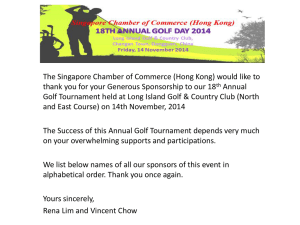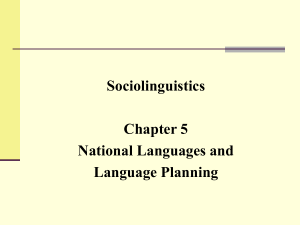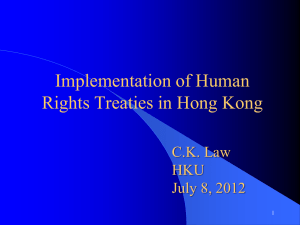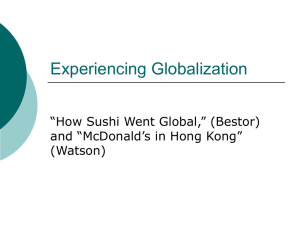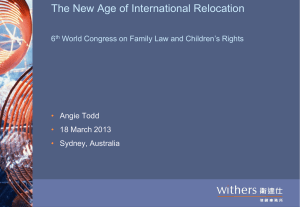Hong Kong`s Contribution to China`s Reform and Liberalisation
advertisement
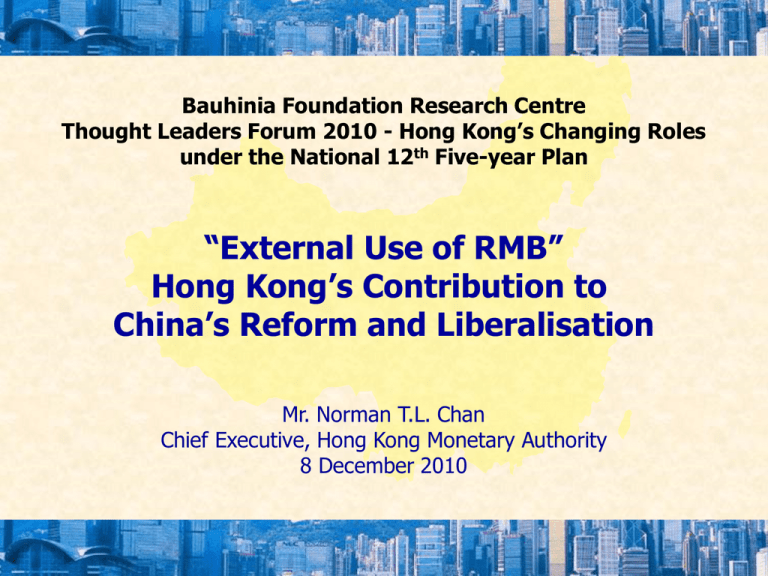
Bauhinia Foundation Research Centre Thought Leaders Forum 2010 - Hong Kong’s Changing Roles under the National 12th Five-year Plan “External Use of RMB” Hong Kong’s Contribution to China’s Reform and Liberalisation Mr. Norman T.L. Chan Chief Executive, Hong Kong Monetary Authority 8 December 2010 China’s reform and liberalisation Hong Kong’s role and contribution To plan for the future, there is a need to understand the past and the present Hong Kong has played an important and irreplaceable role in the country’s reform and liberalisation over the past 30 years Hong Kong’s contribution will continue and increase over time 2 Hong Kong as the key intermediation platform for Mainland’s trade Re-exports and offshore trade of Mainland USD billion origin intermediated through Hong Kong 800 100 Offshore trade conducted through Hong Kong (lhs) Re-exports conducted through Hong Kong (lhs) 700 % 90 80 600 70 500 60 Re-export and offshore trade conducted through Hong Kong as a share of Mainland's trade (rhs) 400 50 40 300 30 200 20 100 10 0 0 84 86 88 90 92 94 96 98 00 02 04 06 08 During 1980-90’s, Hong Kong was the key re-export port for Mainland’s trade. With improved port facilities in the Mainland, Hong Kong has transformed itself into an offshore trading centre. Nowadays, about 30% of Mainland’s trade (including re-exports and offshore trade) is intermediated through Hong Kong. 3 Contribution of trade intermediation services to the Hong Kong economy HKD billion Contribution of China-related trade intermediation services to Hong Kong 800 % GDP 40 Offshore trade earnings (lhs) Re-export earnings of China origin (lhs) 700 35 600 30 As a share of Hong Kong's GDP (rhs) 500 25 400 20 300 15 200 10 100 5 0 0 89 91 93 95 97 99 01 03 05 07 09 The fast-growing Mainland economy has provided an impetus for the development of re-export and offshore trade in Hong Kong. Over the past 20 years, gross earnings from Mainland-related trade intermediation services increased from an equivalent of 9% of GDP in 1989 to 34% in 2009. 4 Hong Kong is the largest source of Mainland’s foreign direct investments FDI to Mainland China USD billion % 120 100 (lhs) Hong Kong Virgin Islands Japan US Others 90 100 80 Share of Hong Kong (rhs) 70 80 60 60 50 40 40 30 20 20 10 0 0 86 88 90 92 94 96 98 00 02 04 06 08 Since the opening up and reform of the Mainland 30 years ago, Hong Kong has been the largest source of Mainland’s foreign direct investments (FDI). While the share of Mainland’s FDI coming from Hong Kong was once on a decline, it has rebounded and accounted for half of Mainland’s total in 2009. 5 Hong Kong as a bridge for Mainland enterprises investing overseas USD billion 80 (lhs) Outward direct investments from Mainland China Hong Kong Other Asia OFCs Australia % 80 Others 70 70 60 60 50 50 40 30 40 Share of Hong Kong (rhs) 30 20 20 10 10 0 0 03 04 05 06 07 08 09 Hong Kong also serves as a “window” and a “bridge” facilitating outward direct investments (ODI) by Mainland enterprises. In 2009, Mainland’s ODI increased to US$57 billion, of which 60% was invested in Hong Kong or through Hong Kong to overseas. 6 Hong Kong as a key fund-raising platform for Mainland enterprises Cumulative amount of funds raised by Mainland % enterprises in Hong Kong stock market USD billion 70 800 Other enterprises (rhs) Mainland enterprises (rhs) 60 700 600 50 Share of Mainland enterprises (lhs) 500 40 400 30 300 20 200 10 100 0 0 93 94 95 96 97 98 99 00 01 02 03 04 05 06 07 08 09 10 *As of October, 2010. Hong Kong’s stock market provides an efficient fund-raising platform for Mainland enterprises. In the past 20 years, Mainland enterprises raised a total of US$360 billion, accounting for more than half of the funds raised in the Hong Kong stock market. Hong Kong continues to play this role today. 7 Hong Kong as a springboard for Mainland banks to develop overseas business HKD billion Source of growth of Mainland banks operating in Hong Kong HKD billion 2,200 2,200 20% of total bank assets in Hong Kong 2,000 2,000 1,800 1,800 1,600 1,600 Assets of Mainland banks in Hong Kong 1,400 Organic growth 1,400 1,200 1,200 1,000 1,000 800 800 Mergers & Acquisitions 600 600 400 400 200 200 0 0 99 00 01 02 03 04 05 06 07 08 09 Hong Kong has been the prime location for Mainland banks to expand their business overseas. During the past 10 years, the asset size of Mainland banks operating in Hong Kong increased rapidly, reaching HK$2 trillion or 20% of total bank assets in Hong Kong at the end of 2009. 8 Hong Kong’s competitive edge as global hub for wealth and assets International investment positions: assets and liabilities USD trillion (% GDP) USD trillion (% GDP) 7 7 Assets Liabilities 6 6 5 5 2.9 tn (57%) 4 4 3 1.8 tn (37%) 740 bn (352%) 680 bn (138%) 3 440 bn (247%) 2 1 1 0 0 Japan 2 China Hong Kong Switzerland Singapore As at end-2009, Hong Kong’s international investment position (IIP) assets reached US$2.6 trillion or 12 times of GDP. Meanwhile, the net IIP assets stood at US$740 billion or 3.5 times of GDP. 9 Huge potential for RMB as a currency for trade settlement Mainland’s trade with major trading partners % 9 USD billion 3,000 8.8% 8 2,500 7 Others 22,059 6 2,000 US 5 Mainland's trade as a share of world total (lhs) 4 EU 3 1,500 1,000 Asia 1,172 (53.1%) 2 500 1 0 0 95 96 97 98 99 00 01 02 03 04 05 06 07 08 09 Mainland China is the world’s second largest trading economy after the US, accounting for 9% of global trade. Of which, Asia accounts for more than half of Mainland’s trade. Hence, the potential for RMB as a currency for trade settlement is huge. 10 Asia is Mainland’s largest trading partner Korea 2003: 20 bn 2009: 54 bn (+167%) Figures represent Mainland’s exports in US dollar. Figures in ( ) represent the growth rate. Japan 2003: 59 bn 2009: 98 bn (+65%) ASEAN 2003: 31 bn 2009: 1,06 bn (+244%) Growth of Mainland’s exports to Asia has been robust. During 2003-09, Mainland’s exports to Japan, Korea and ASEAN increased by 65%, 167 and 244% respectively. This suggests that there is ample scope for a wider use of RMB for trade settlement in the region. 11 Mainland’s trade with regions outside Asia is also growing strongly Eastern Europe 2003: 12 bn 2009: 40 bn (+231%) Figures represent Mainland’s exports in US dollar. Figures in ( ) represent the growth rate. Central Asia 2003: 2 bn 2009: 17 bn (+710%) Australia 2003: 6 bn 2009: 21 bn (+230%) Latin America 2003: 12 bn 2009: 57 bn (+380%) In recent years, Mainland’s exports to regions outside Asia has been increasing significantly. During 2003-09, Mainland’s exports to Australia, Eastern Europe, Latin America and central Asia rose by two to seven times. With the rapid expansion of Mainland’s trade with the emerging economies, there is also ample scope for a wider use of RMB for international trade settlement. 12 China is the key source of growth of global economy Sources of global economic growth 100% Others (12%) Japan (2%) Euro zone(5%) 80% US (10%) BRIC exChina (16%) 60% Emerging Asia (19%) 40% 20% 70% 38% China (35%) 0% 2000 2006 2010 2015 As projected by the IMF, more than one-third of global growth would be contributed by Mainland China by 2015. It is expected that the importance of Mainland China in the global economy and financial system will also increase accordingly. 13 External use of RMB Prospects of HK as an offshore RMB centre Hong Kong is an established international financial centre, and also an important centre of capital and funds With Mainland as the hinterland and its international links, Hong Kong is the ideal window, springboard and testing ground for the external use of RMB Given the rapid growth of China’s cross-border trade and investment flows, there is huge potential for the Hong Kong offshore RMB platform to contribute and support real economic activities in China and the region The offshore RMB market in Hong Kong is also linking up with the sizable onshore financial market in the Mainland, paving the way for China to link up with the international capital markets 14



